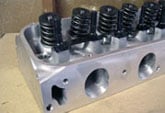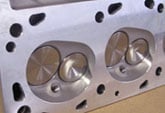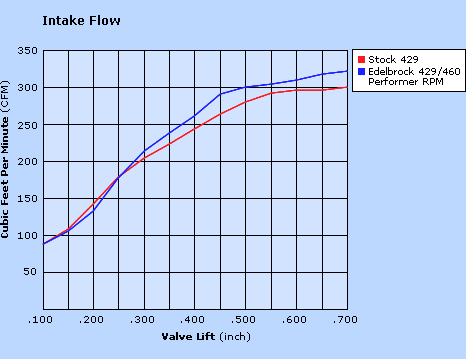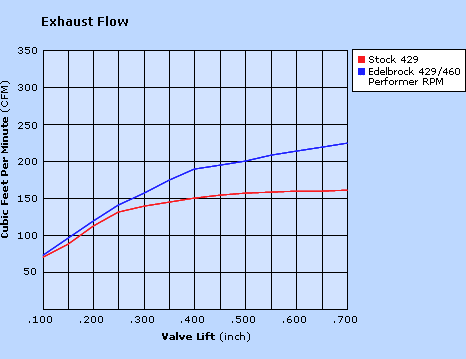|

Copy and Photos by Jon Mikelonis
Introduction
Everyday that passes by leaves a smaller chance to score
a working man's deal on a pair of 429CJ, SCJ, or Police
Interceptor heads for a street smart 385-series Ford
buildup. It's true that owning a pair will make great
conversation among fellow enthusiasts. Practically speaking
however, it doesn't make sense to hunt down and pay
for a pair of these now obscure factory heads when mainstream
429 and 460 heads perform quite well for street applications.
Furthermore, aftermarket aluminum offerings have long
improved on the original design's shortcomings and depending
on where you allocate your coin, they can fit a BBF
buildup's budget quite well.
|

 In the RPM line Edelbrock offers two options for
the 385 series motor. Low octane gas and torque
were critical requirements for our application
so we chose the more streetable casting with a
95cc combustion chamber and 292cc intake runner.
In the RPM line Edelbrock offers two options for
the 385 series motor. Low octane gas and torque
were critical requirements for our application
so we chose the more streetable casting with a
95cc combustion chamber and 292cc intake runner.
|
FordMuscle originally intended to optimize a pair of
standard '73 429 castings (D2VE-AA) for our Streetwise
460. After all, with a 2.09" intake valve and
1.66" exhaust valve, standard is not a bad thing
when it comes to the 385-series cylinder head. Since
we saved some cash when we scored a low mileage bottom-end,
we were able to restructure our budget for top-end power
producing speed parts. Edelbrock's affordably priced
and fully assembled Performer RPM 460 Aluminum Cylinder
Head peaked our interest with a 2.19" intake and
1.76" exhaust valve. Out of the box convenience,
streetable runner and chamber dimensions, and the opportunity
to shed a few pounds off our project car contributed
to our decision go with Edelbrock's offering. In the
Performer RPM line, Edelbrock offers two head designs
for the 385-series motor. Low octane pump gas and bottom
end torque were critical requirements so we chose the
more street friendly casting. Part number 60669. This
head uses a 95cc combustion chamber and 292cc smaller
intake runner.
Flow Testing
In order to found out what a $1760.00 investment was
going to yield in flow performance, we took both our
factory 429 head and Performer RPM head to Cylinder
Head Dynamics of Tracy, California. Paul Widger used
his Super Flow 600 on the D2VE-AA casting to create
a baseline for us to compare the flow performance of
the Edelbrock head. Both heads were measured using a
4.50" bore, a critical figure that Paul says is
often absent from documentation that reports flow data.
Of course we expected a great increase in flow over
the factory iron head considering Edelbrock's increased
valve size, but what else might a flow test uncover?


| Intake and Exhaust
Flow (CFM 28" H20) |
| lift (in.) |
.100 |
.150 |
.200 |
.250 |
.300 |
.350 |
.400 |
.450 |
.500 |
.550 |
.600 |
.650 |
Stock
Intake |
81 |
111 |
144 |
176 |
202 |
221 |
240 |
258 |
271 |
283 |
290 |
290 |
Edelbrock
Intake |
75 |
109 |
141 |
174 |
208 |
238 |
260 |
282 |
297 |
303 |
309 |
316 |
Stock
Exhaust |
69 |
91 |
112 |
131 |
140 |
146 |
150 |
153 |
154 |
156 |
156 |
157 |
Edelbrock
Exhaust |
68 |
94 |
116 |
136 |
154 |
169 |
181 |
191 |
200 |
207 |
212 |
214 |
|
*All flow measurements taken
at 4.50" bore diameter
|
By studying the flow data between these two heads you'll
see that the factory 429 head flows relatively well
on the intake side. Even in unmodified and neglected
form, the stock casting flowed an average of 216 cfm
between .200" and .500" lift. The Performer
RPM head flowed an average of 229 cfm between the same
lift range. Well you might be asking yourself at this
point, other than the weight reduction, what is the
significant advantage of the Performer RPM 460 head?
As you will discover in the following analysis and Q
& A, the answer lies in the exhaust data.
|